Well, the holiday season is already here once again.
For ecommerce store owners, this time of year presents some major opportunities to spread brand awareness, enhance audience engagement, and spur sales and revenue numbers. In fact, eMarketer projects that US-based ecommerce sales will soar over $135 billion throughout the next month.
Of course, this doesn’t just apply to your company; it also applies to your competitors, as well.
Point being, despite the fact that the modern consumer is typically primed for engagement during the holiday season, there’s no guarantee that they’ll engage with your brand. To be sure, you’ll likely be facing your fair share of competition over the course of the next month or so.
Regardless of whether or not your team feels prepared to take advantage of the busy, consumer-focused holiday season, there will always be more you can do in the weeks leading up to Black Friday weekend and beyond.
Here, we’ll provide five last-minute marketing strategies you may decide to use for your overall holiday campaign.
Since time is of the essence, let’s dive in.
1. Offer Deals and Options for Fulfillment and Delivery
Speaking of time being of the essence, a main concern of holiday shoppers is whether they’ll receive their orders in time for Christmas or their respective holiday.
Case in point, data collected by ConveyCo shows that 46% of consumers expect to receive packages in less time than in previous years. Moreover, the data shows that 97% of consumers believe delivery speed to be important to their purchasing decisions—with 60% saying they’ve abandoned a purchase due to poor delivery speed.
Along that same line, Narvar found that 53% of consumers won’t even consider making a purchase if time of delivery isn’t communicated clearly.

So, first and foremost, you’ll need to ensure that your holiday delivery processes are both transparent and efficient.
In terms of transparency, you need to be clear as to how long it will take for a specific delivery to be made, as well as to any “cutoff” period your audience should be aware of. Not only does this keep your audience informed, but it also instills a sense of urgency in them, as well.
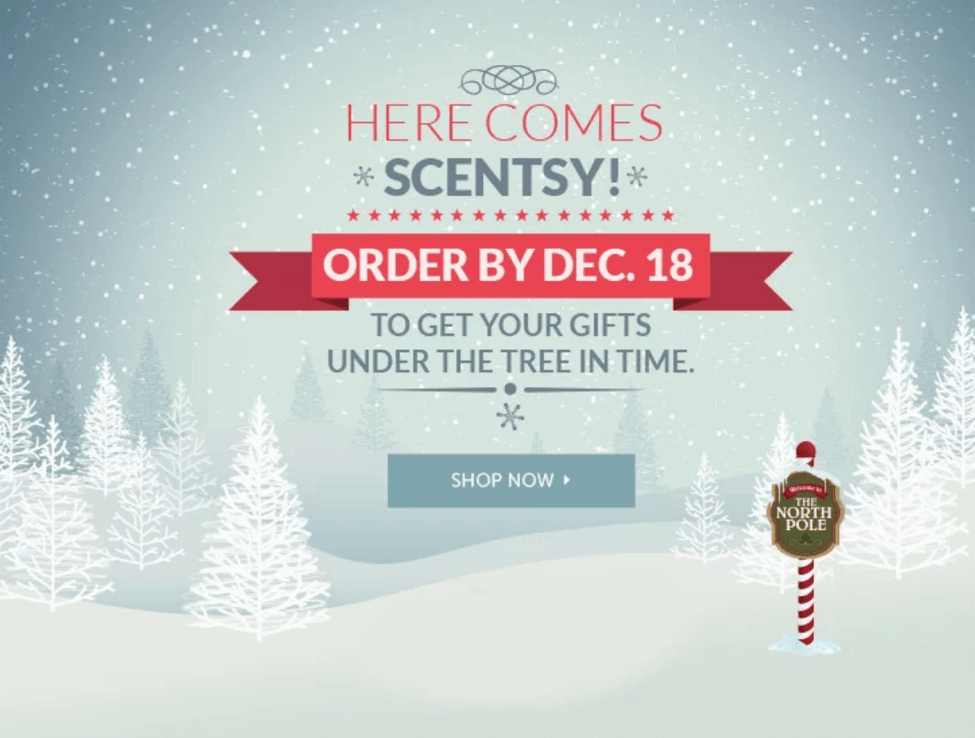
Regarding efficiency, well…you simply need to ensure your fulfillment team is equipped and prepared for the holiday rush. Unfortunately, the modern consumer typically doesn’t care about what it takes for you to deliver their orders on time; they just want it to happen.
Now, you certainly can use your audience’s increased expectations to your advantage, here.
There are two key ways to go about this:
First, consider temporarily offering free shipping deals on orders that meet certain qualifications. Typically, these offers come in the form of order value thresholds:

Here, the idea is to identify a target order value that will make it worthwhile for your company to eat the cost of shipping. Of course, the added bonus is that such an order—should your audience take advantage of it—will boost your conversion rate and overall average order value throughout the holiday season.
Your other option is to promote offers revolving around a trade-off between delivery time and cost of shipping. Basically, the idea is to allow consumers to pay additional fees in exchange for quicker delivery—or, conversely, to provide low-cost or free shipping to those who place their orders well ahead of time.
(Note: While these approaches certainly can be used year-round, it’s important to make such offers as visible as possible during this high-stakes time of year.)
One final option that you may have, if your retail store operates in brick-and-mortar form of any kind, is to offer “buy online, pickup in-store” deals to your audience. This can allow you to subvert the entire notion of delivery fees and timing, as it allows your customers to take control of when and where they receive their orders from your company.
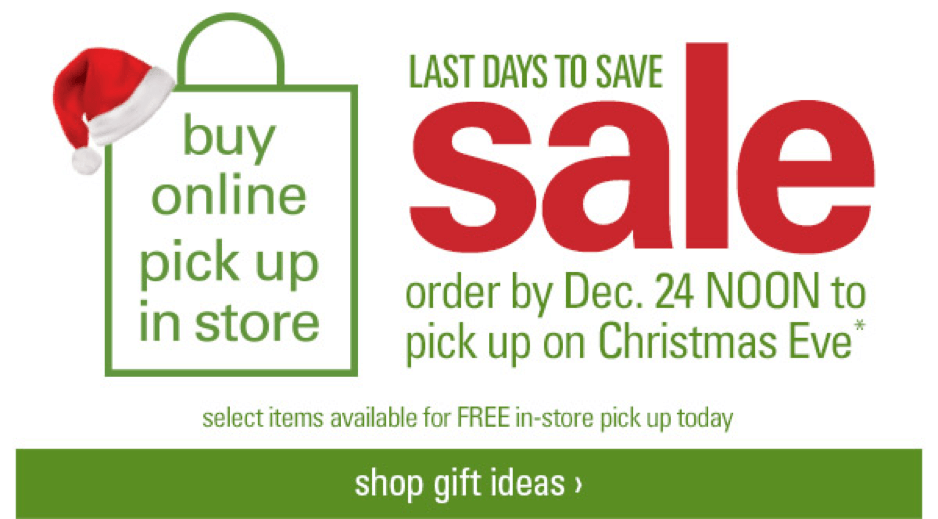
Overall, it’s vital to give your audience as many options as possible with regard to holiday shipping. In doing so, you can help alleviate any hesitations they may have when looking to make a purchase from your company.
2. Enable Proper Gift-Giving with “G-Commerce”
You don’t need us to tell you that, during the holiday season, consumers are generally more prone to purchasing gifts for friends, family members, and other loved ones.
What you may find surprising, though, is that over 60% of brands responding to a survey by Shopify earlier this year said they would not be offering gift bundles during this year’s holiday season. On a related note, data collected by Forbes shows that 38% of gift recipients returned at least one gift after the 2015 holiday season came to a close.
The point is, promoting gift bundles and the like can often backfire on ecommerce companies. Should recipients decide to return their unwanted gifts, this not only leads to lost sales upfront for the company in question, but also to additional costs incurred as the organization processes these returns.
So, instead of promoting specific gift ideas, bundles, etc., many ecommerce companies have begun implementing what’s referred to as “g-commerce,” or gift commerce.
The idea, here, is to allow consumers to digitally “deliver” gifts to their loved ones before actually placing an order. From there, the recipient has the option of:
- Completing the order as is
- Tailoring the order to their liking (e.g., changing the size of a piece of clothing)
- Exchanging the potential gift for another item of equal or lesser value
- Exchanging the potential gift in full for store credit (or, in some cases, a complete refund to be given to the original buyer)
Now, while this tactic can certainly prove effective in certain cases, it’s worth taking a step back and noticing the “big picture,” here.
The fact is, the concept of “it’s the thought that counts” is in many ways becoming obsolete. Many consumers actually appreciate receiving gift cards, or otherwise would rather have a choice as to the gift they receive instead of receiving a not-so-awesome gift in the first place. Moreover, gift-givers are more apt to purchase gift cards than actual products for their loved ones.
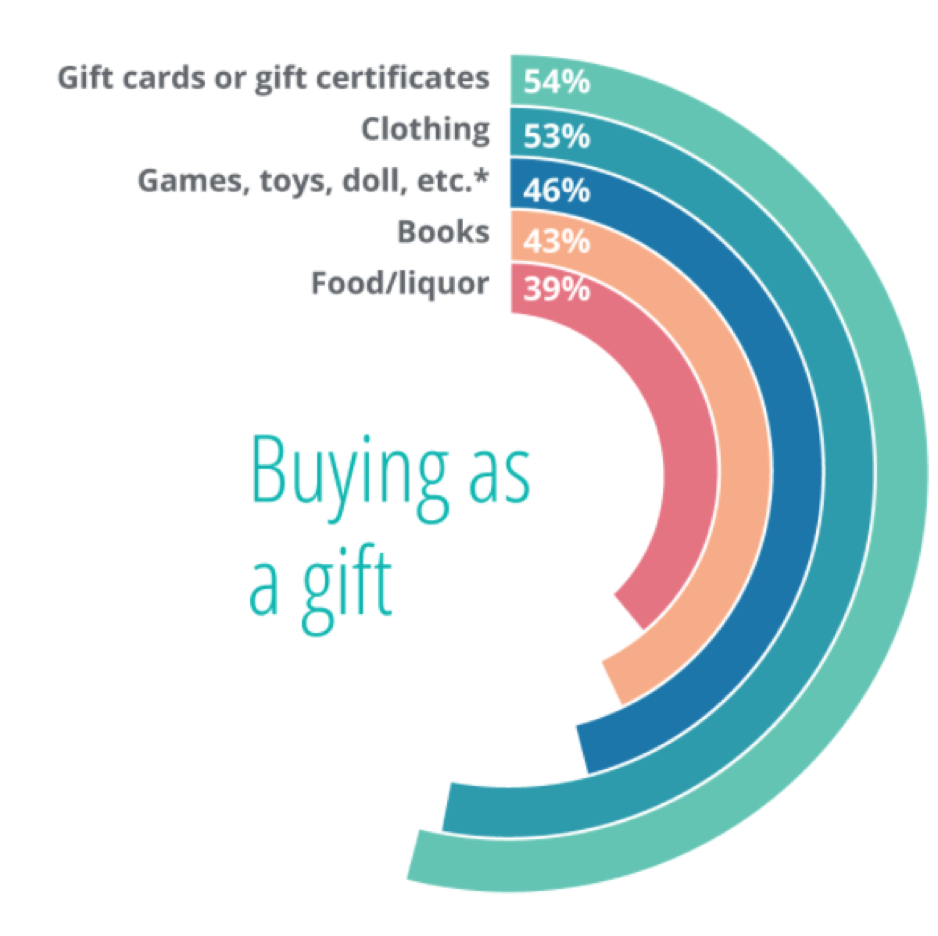
That said, you may want to ease back on promoting gift suggestions to your audience—and double-down on promoting gift cards, certificates, or other such vouchers. Not only will it lead to a more pleasant experience for the gift-giver and receiver, but it will also lead to much less of a headache for your fulfillment team as well.
3. Sell to the End-User
Though we just discussed the notion that gift-giving increases during the holiday season, this isn’t to say that consumers don’t also make purchases for themselves during this time.
In fact, according to the Deloitte report mentioned above, 78% of consumers say they make gift-type purchases for themselves during the holiday season.
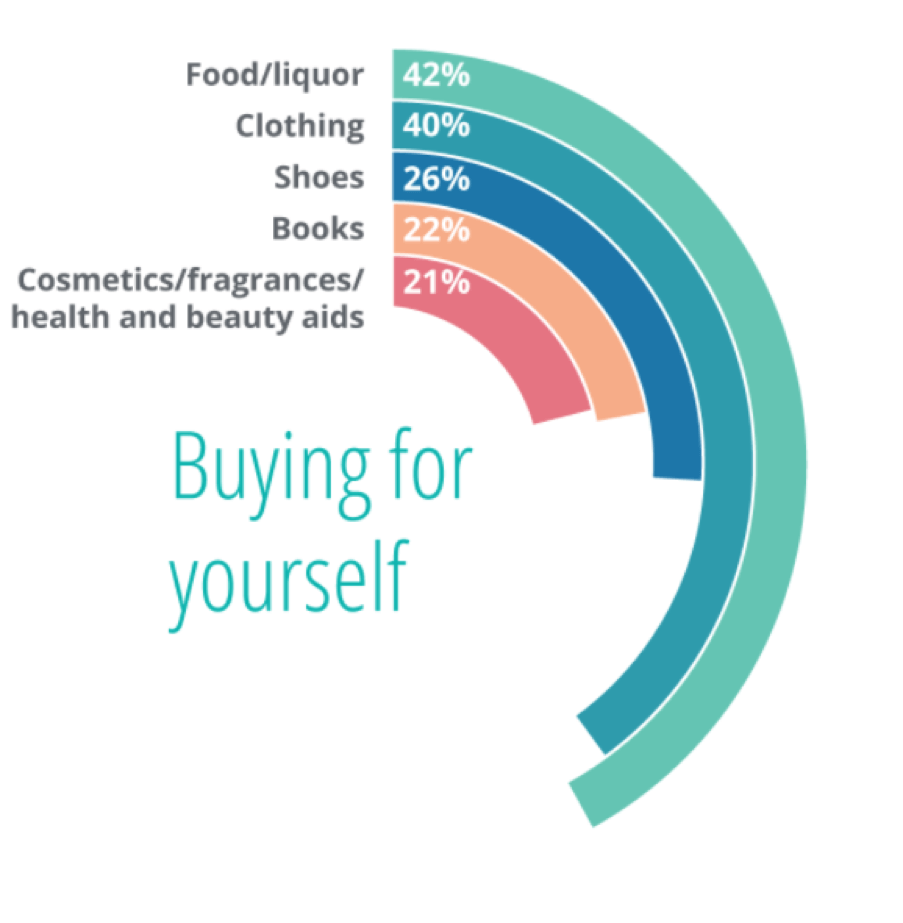
As the above graphic shows, these purchases revolve around the theme of comfort, relaxation, and self-care. To be sure, your store doesn’t necessarily need to offer these specific products—but you absolutely should keep this theme in mind.
There are a number of ways to do this:
While we just advised against offering gift baskets or bundles to consumers looking to purchase gifts for others, you may want to consider offering them to consumers looking to buy for themselves. Since these “self-gift-givers” obviously have a better idea of what they’re looking for in such bundles, it just makes sense to give them what they want.
In that same vein, you might also decide to go the experiential route, promoting the cohesive, thematic experience your audience stands to receive through the use of your related products. This may involve offering samples of various products in a bundle, along with “extras” (e.g., usage guides, recipes, etc.) to supplement the value of the products in question.
Or, you may want to tap into your audience’s yearning to both give and receive an enjoyable experience during the holiday season. Rather than simply promoting “buy one, get one” sales, though, consider refashioning them as “buy one, give one” (or, alternatively, “give one, get one”) promotions. Here, the focus can be on sharing an experience with a loved one, or in giving a gift to those in need.

Regardless of how you approach it, the simple fact is that every customer deserves to experience satisfaction and comfort throughout the holiday season. Whether an individual purchases this experience for themselves, for others, or both is none of your concern; all that matters to you is that you’re able to provide this pleasurable experience to as many people as possible.
4. Solicit and Promote Thematic User-Generated Content
Not to advise that you pass the buck to your customers, but:
If you’re looking for a way to increase and enhance audience engagement throughout the holiday season at the last-minute, you absolutely want to consider ramping up your UGC campaigns.
There are two key ways to go about doing this:
First, you might choose to create a holiday-themed UGC calendar or countdown, in which you prompt your audience to create different types of content on a daily basis as the season unfolds.
For example, last year Sun-Maid created its “12 Days of Sun-Maid” sweepstakes, prompting consumers to post photos or videos on Twitter and Instagram showcasing their favorite holiday memories:
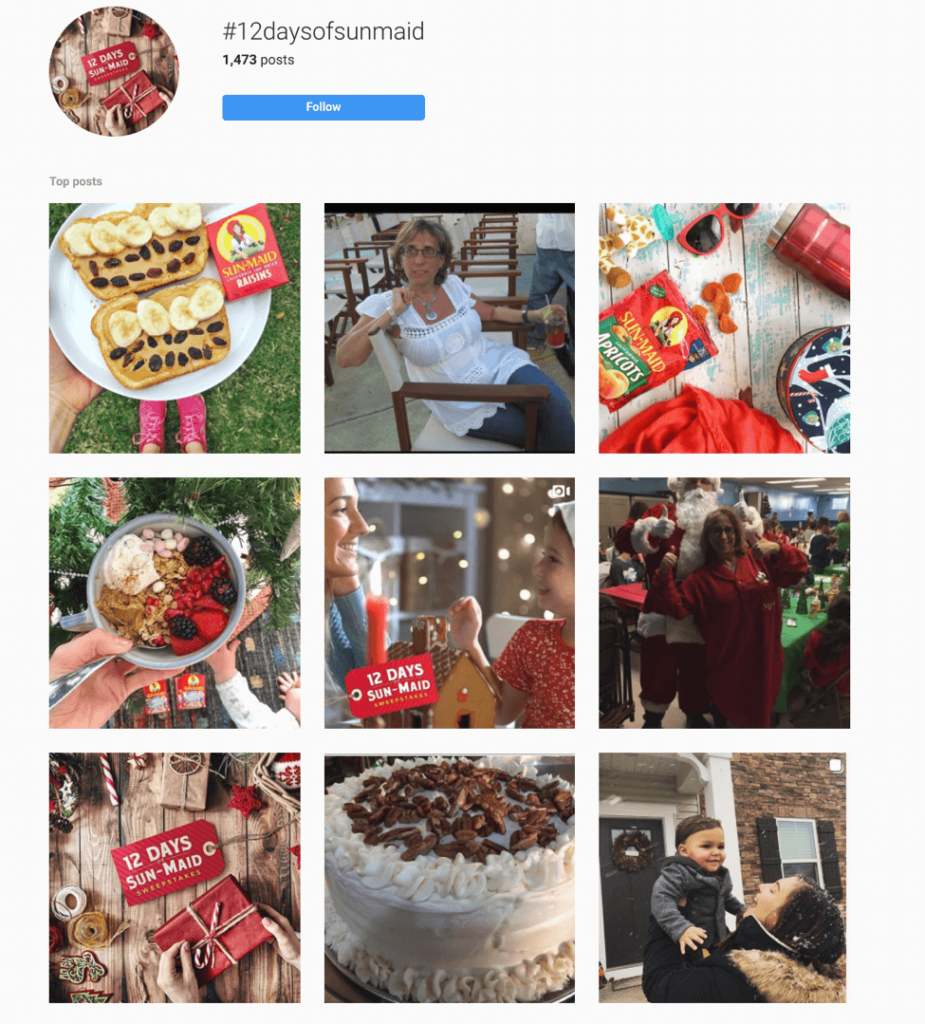
As shown above, the contest drew over 1,400 participants—along with 1,400 pieces of content on Instagram alone. It’s also worth noting that many of these posts were created outside of the actual contest’s window—meaning many consumers were willing to participate simply to be a part of the community created by Sun-Maid.
You can also take a page from Barnes & Nobles’ book (sorry), and prompt your audience to make gift suggestions to one another. In Barnes & Nobles’ case, the team took to Twitter with the branded hashtag #bngifttip:
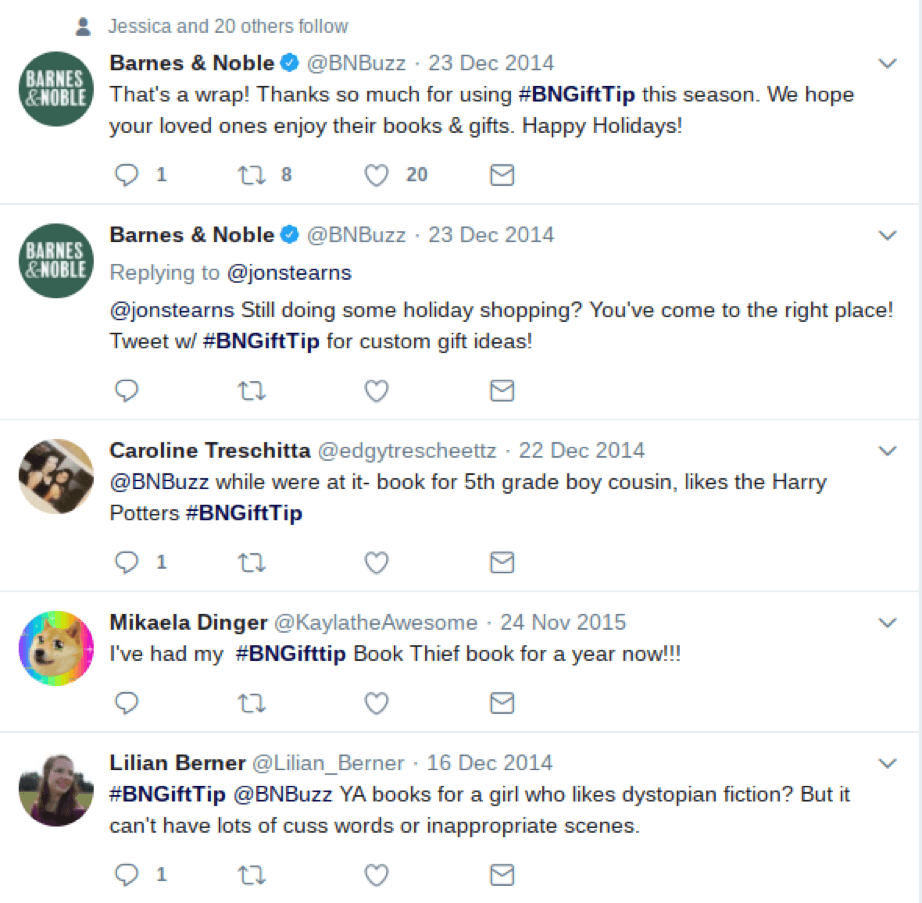
The premise is that gift-givers would describe the individual they planned on purchasing a book for, and other members of the community would provide suggestions to them. Here, the idea was to leverage the experienced customer’s literary knowledge to provide laser-focused gift suggestions—instead of promoting internal suggestions that may or may not hit their mark.
Piggybacking off that last point, you also want to make any positive reviews, mentions, or other social proof regarding your products as prominent as possible during the holiday season (and, to be sure, throughout the rest of the year as well).
According to data collected by Rivet Works:
- 67% of consumers purchase as gifts products they see on social media
- 65% of consumers specifically rely on UGC on social media to find the “perfect gift” for their loved ones
- High-quality UGC that showcases your products and brand in a positive light can increase the likelihood of purchase by up to 640%
So, again:
Whether via social media posts, targeted ads, promotional or transactional emails, or any other marketing content, it’s imperative that you present social proof to potential customers throughout the holiday season.
5. Maintain Post-Holiday Engagement
You’re probably well aware that the world of retail and ecommerce doesn’t just go back to “business as usual” after the holidays have come and gone.
For one thing, the week after Christmas, as we’ve discussed, is prime time for gift-receivers to start making returns and exchanges. While you’ll ideally have taken measures to minimize the amount of returns your company experiences, you likely won’t be able to avoid these processes altogether.
The next best thing, then, is to make the most of these engagements.
For starters, you’ll want to have clear returns and exchanges policies in place that benefit both the consumer and your company.
One way to find the “middle ground,” here, is to offer incentivized store credit for returns. Basically, the idea is to attach a fee to returners looking to receive monetary reimbursement for their returns—and to waive this fee for those who choose to receive store credit, instead.
(To be sure, getting this right is a matter of digging into your operational costs, consumer expectations, and a variety of other factors. But, if you can manage to find the “sweet spot” that benefits both your business and your audience, you can at least minimize the damage done by the in-flux of returns as the holidays come to a close.)
Rather than focusing on how to minimize losses, though, let’s turn our attention to what you can do to maximize the value received (by both parties) during a return or exchange engagement.
While it sounds pretty obvious, it’s important to understand that consumers return gifts because they don’t want the item in question.
But, that doesn’t mean they don’t want anything at all. Maybe they did want the item, just in a different size or color. Or, they didn’t want that item, but are interested in a similar product of different quality. Or, maybe they loved the gift they received, but don’t have much use for it without proper accessories.
In these scenarios, you have some options:
- Upselling returning customers by showcasing similar products of higher quality and value
- Downselling returning customers by showcasing similar, yet lower-priced items
- Cross-selling related items that supplement the value of the original item in question
The goal is to avoid straight-up returns (which leaves your business at a loss), while also providing value to gift-returners in a way that actually matters to them.
Finally, there are a number of ways to approach your overall marketing campaigns as the holidays come to an end, such as:
- Post-holiday gift-giving promotions for those who couldn’t find the perfect gift
- Remarketing follow-ups for those who abandoned their cart pre-holiday
- “Out with the old” sales, allowing you to offload this year’s inventory in preparation for newer products
- “New Year, New You” promotions for consumers looking to get a fresh start in some way come January
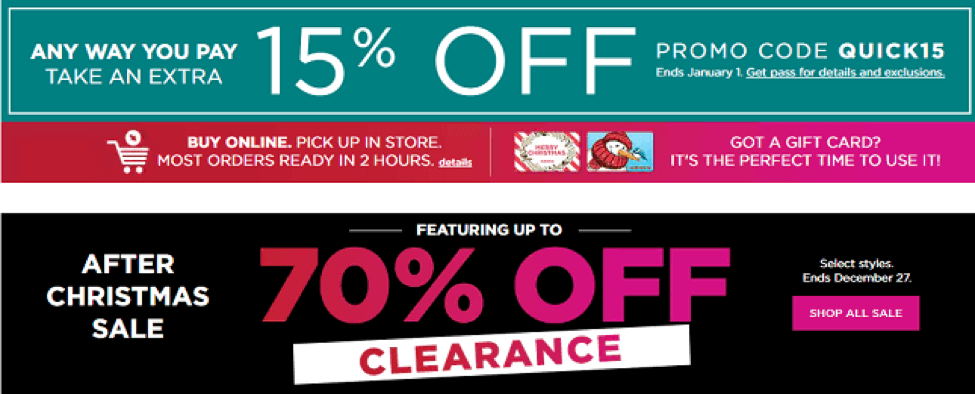
As the holidays come to an end, it can be tempting to just sit back and catch your breath a bit. But, you’ll be missing out on some major opportunities if you do.
Instead, keep moving ahead at full throttle—and you’ll easily find yourself ahead of your competitors who have chosen to rest on their laurels.
Wrapping Up
If you’re feeling a bit under-prepared for the holiday rush, you still have some time to get things moving in the right direction—as long as you know where you’re headed.
So, the only thing left for you to do is to get moving—and make this holiday season one that your customers and your company won’t soon forget.
Improve your cash flow today
Apply to get daily payments and capital for your growing business in as fast as one business day. No credit checks or external documents required.
Need more information? Call us at (646) 494-8675 or email sales@payability.com


